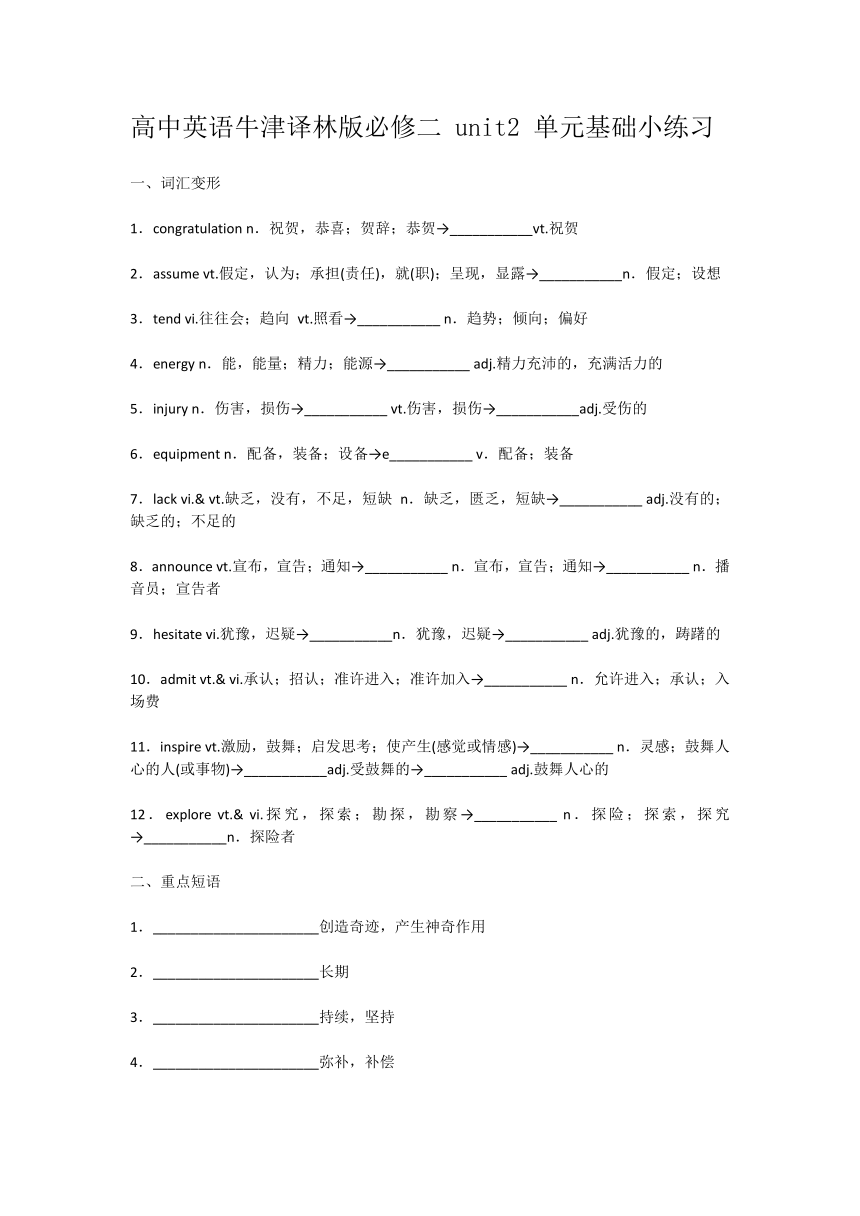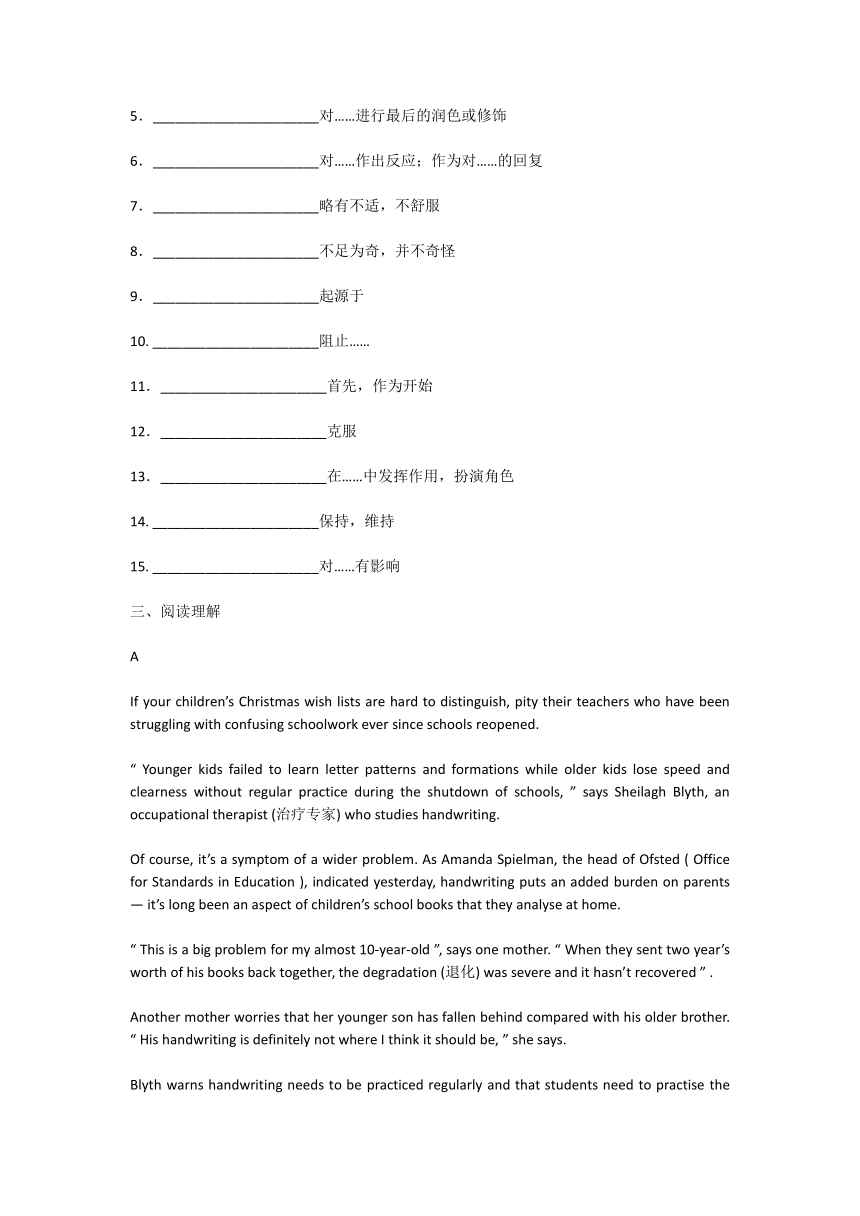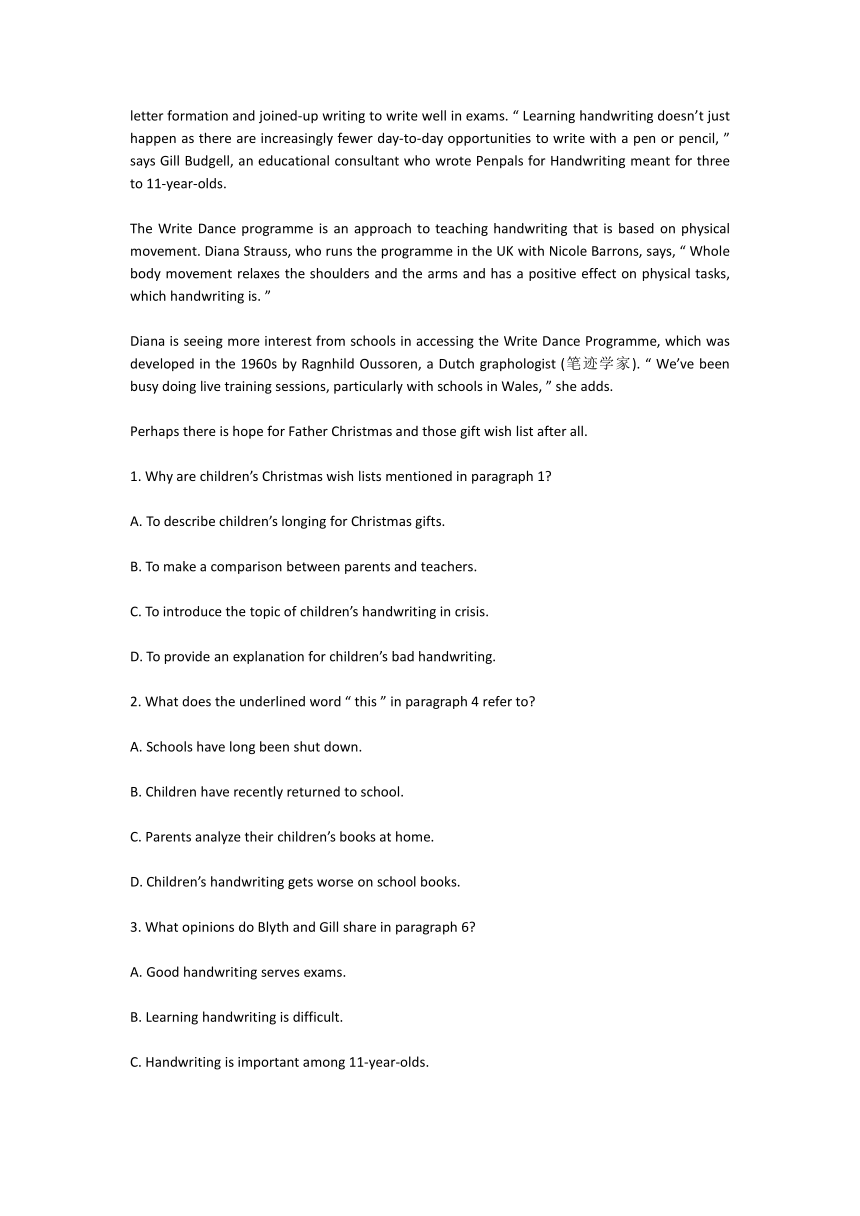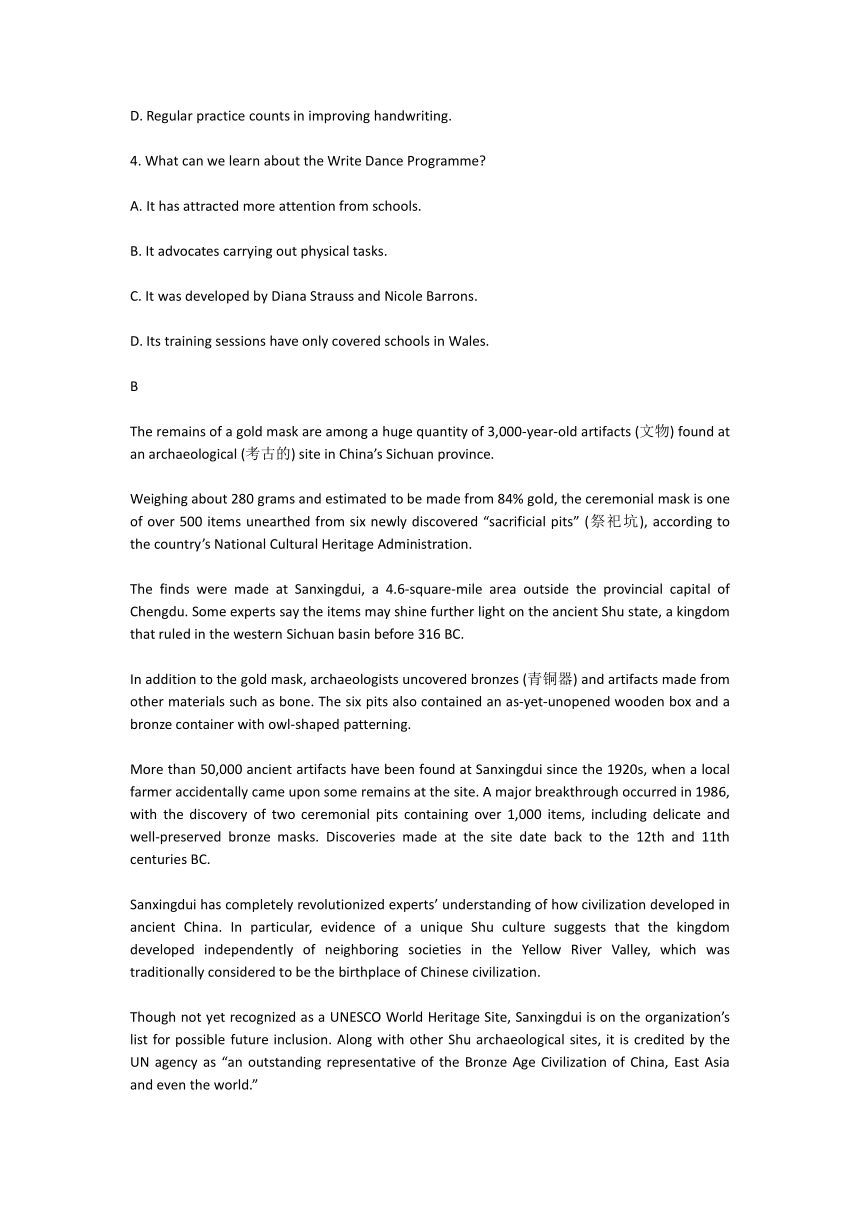牛津译林版(2019)必修二 unit 2 Be sporty,be healthy单元基础小练习(有答案)
文档属性
| 名称 | 牛津译林版(2019)必修二 unit 2 Be sporty,be healthy单元基础小练习(有答案) |

|
|
| 格式 | zip | ||
| 文件大小 | 15.6KB | ||
| 资源类型 | 教案 | ||
| 版本资源 | 牛津译林版(2019) | ||
| 科目 | 英语 | ||
| 更新时间 | 2022-10-07 16:28:45 | ||
图片预览




文档简介
高中英语牛津译林版必修二 unit2 单元基础小练习
一、词汇变形
1.congratulation n.祝贺,恭喜;贺辞;恭贺→___________vt.祝贺
2.assume vt.假定,认为;承担(责任),就(职);呈现,显露→___________n.假定;设想
3.tend vi.往往会;趋向 vt.照看→___________ n.趋势;倾向;偏好
4.energy n.能,能量;精力;能源→___________ adj.精力充沛的,充满活力的
5.injury n.伤害,损伤→___________ vt.伤害,损伤→___________adj.受伤的
6.equipment n.配备,装备;设备→e___________ v.配备;装备
7.lack vi.& vt.缺乏,没有,不足,短缺 n.缺乏,匮乏,短缺→___________ adj.没有的;缺乏的;不足的
8.announce vt.宣布,宣告;通知→___________ n.宣布,宣告;通知→___________ n.播音员;宣告者
9.hesitate vi.犹豫,迟疑→___________n.犹豫,迟疑→___________ adj.犹豫的,踌躇的
10.admit vt.& vi.承认;招认;准许进入;准许加入→___________ n.允许进入;承认;入场费
11.inspire vt.激励,鼓舞;启发思考;使产生(感觉或情感)→___________ n.灵感;鼓舞人心的人(或事物)→___________adj.受鼓舞的→___________ adj.鼓舞人心的
12.explore vt.& vi.探究,探索;勘探,勘察→___________ n.探险;探索,探究→___________n.探险者
二、重点短语
1.______________________创造奇迹,产生神奇作用
2.______________________长期
3.______________________持续,坚持
4.______________________弥补,补偿
5.______________________对……进行最后的润色或修饰
6.______________________对……作出反应;作为对……的回复
7.______________________略有不适,不舒服
8.______________________不足为奇,并不奇怪
9.______________________起源于
10. ______________________阻止……
11.______________________首先,作为开始
12.______________________克服
13.______________________在……中发挥作用,扮演角色
14. ______________________保持,维持
15. ______________________对……有影响
三、阅读理解
A
If your children’s Christmas wish lists are hard to distinguish, pity their teachers who have been struggling with confusing schoolwork ever since schools reopened.
“ Younger kids failed to learn letter patterns and formations while older kids lose speed and clearness without regular practice during the shutdown of schools, ” says Sheilagh Blyth, an occupational therapist (治疗专家) who studies handwriting.
Of course, it’s a symptom of a wider problem. As Amanda Spielman, the head of Ofsted ( Office for Standards in Education ), indicated yesterday, handwriting puts an added burden on parents — it’s long been an aspect of children’s school books that they analyse at home.
“ This is a big problem for my almost 10-year-old ”, says one mother. “ When they sent two year’s worth of his books back together, the degradation (退化) was severe and it hasn’t recovered ” .
Another mother worries that her younger son has fallen behind compared with his older brother. “ His handwriting is definitely not where I think it should be, ” she says.
Blyth warns handwriting needs to be practiced regularly and that students need to practise the letter formation and joined-up writing to write well in exams. “ Learning handwriting doesn’t just happen as there are increasingly fewer day-to-day opportunities to write with a pen or pencil, ” says Gill Budgell, an educational consultant who wrote Penpals for Handwriting meant for three to 11-year-olds.
The Write Dance programme is an approach to teaching handwriting that is based on physical movement. Diana Strauss, who runs the programme in the UK with Nicole Barrons, says, “ Whole body movement relaxes the shoulders and the arms and has a positive effect on physical tasks, which handwriting is. ”
Diana is seeing more interest from schools in accessing the Write Dance Programme, which was developed in the 1960s by Ragnhild Oussoren, a Dutch graphologist (笔迹学家). “ We’ve been busy doing live training sessions, particularly with schools in Wales, ” she adds.
Perhaps there is hope for Father Christmas and those gift wish list after all.
1. Why are children’s Christmas wish lists mentioned in paragraph 1
A. To describe children’s longing for Christmas gifts.
B. To make a comparison between parents and teachers.
C. To introduce the topic of children’s handwriting in crisis.
D. To provide an explanation for children’s bad handwriting.
2. What does the underlined word “ this ” in paragraph 4 refer to
A. Schools have long been shut down.
B. Children have recently returned to school.
C. Parents analyze their children’s books at home.
D. Children’s handwriting gets worse on school books.
3. What opinions do Blyth and Gill share in paragraph 6
A. Good handwriting serves exams.
B. Learning handwriting is difficult.
C. Handwriting is important among 11-year-olds.
D. Regular practice counts in improving handwriting.
4. What can we learn about the Write Dance Programme
A. It has attracted more attention from schools.
B. It advocates carrying out physical tasks.
C. It was developed by Diana Strauss and Nicole Barrons.
D. Its training sessions have only covered schools in Wales.
B
The remains of a gold mask are among a huge quantity of 3,000-year-old artifacts (文物) found at an archaeological (考古的) site in China’s Sichuan province.
Weighing about 280 grams and estimated to be made from 84% gold, the ceremonial mask is one of over 500 items unearthed from six newly discovered “sacrificial pits” (祭祀坑), according to the country’s National Cultural Heritage Administration.
The finds were made at Sanxingdui, a 4.6-square-mile area outside the provincial capital of Chengdu. Some experts say the items may shine further light on the ancient Shu state, a kingdom that ruled in the western Sichuan basin before 316 BC.
In addition to the gold mask, archaeologists uncovered bronzes (青铜器) and artifacts made from other materials such as bone. The six pits also contained an as-yet-unopened wooden box and a bronze container with owl-shaped patterning.
More than 50,000 ancient artifacts have been found at Sanxingdui since the 1920s, when a local farmer accidentally came upon some remains at the site. A major breakthrough occurred in 1986, with the discovery of two ceremonial pits containing over 1,000 items, including delicate and well-preserved bronze masks. Discoveries made at the site date back to the 12th and 11th centuries BC.
Sanxingdui has completely revolutionized experts’ understanding of how civilization developed in ancient China. In particular, evidence of a unique Shu culture suggests that the kingdom developed independently of neighboring societies in the Yellow River Valley, which was traditionally considered to be the birthplace of Chinese civilization.
Though not yet recognized as a UNESCO World Heritage Site, Sanxingdui is on the organization’s list for possible future inclusion. Along with other Shu archaeological sites, it is credited by the UN agency as “an outstanding representative of the Bronze Age Civilization of China, East Asia and even the world.”
1. What does the underlined phrase “shine further light on” in paragraph 3 probably mean
A. Make greater progress in. B. Have a deeper influence on.
C. Provide more information about. D. Engage more attention to.
2. Why is the discovery of Sanxingdui so unique
A. It changes experts’ understanding of how Chinese civilization developed.
B. It confirms that the Shu Kingdom developed in the Yellow River Valley.
C. It implies that the Yellow River Valley is the birthplace of Chinese civilization.
D. It shows Sanxingdui symbolizes a fundamental change in Chinese society.
3. What does paragraph 5 mainly deal with
A. Sanxingdui’s history of discovery. B. The world’s recognition of Sanxingdui.
C. The difficulty in discovering Sanxingdui. D. The preservation of Sanxingdui’s remains.
4. Which of the following can be the best title of this passage
A. Sanxingdui Accidentally Discovered by a Local Farmer
B. 3,000-year-old Gold Mask Uncovered in Southwest China
C. Outstanding Representatives of the Bronze Age Kingdom
D. New Addition to the List of UNESCO World Heritage Sites
三、写作:
假设你是红星中学高三学生李华。你和英国好友Jim原定本周末一起外出,你因故不能赴约。请你用英文给他写一封电子邮件,内容包括:
1.表达歉意并说明原因;
2.提出建议并给出理由。
注意:
1.词数100左右;
2.开头和结尾已给出,不计入总词数。
Dear Jim,
____________________________________________________________________________________________________________________________________________________________________________________________________________________________________________________________________________________________________________________________________________________________________________________________________________________________________________________________________________________________________________________________________________________________________________________________________________________________________________________________________
答案:
一、词汇变形
1.congratulation n.祝贺,恭喜;贺辞;恭贺→congratulate vt.祝贺
2.assume vt.假定,认为;承担(责任),就(职);呈现,显露→assumption n.假定;设想
3.tend vi.往往会;趋向 vt.照看→tendency n.趋势;倾向;偏好
4.energy n.能,能量;精力;能源→energetic adj.精力充沛的,充满活力的
5.injury n.伤害,损伤→injure vt.伤害,损伤→injured adj.受伤的
6.equipment n.配备,装备;设备→equip v.配备;装备
7.lack vi.& vt.缺乏,没有,不足,短缺 n.缺乏,匮乏,短缺→lacking adj.没有的;缺乏的;不足的
8.announce vt.宣布,宣告;通知→announcement n.宣布,宣告;通知→announcer n.播音员;宣告者
9.hesitate vi.犹豫,迟疑→hesitation n.犹豫,迟疑→hesitant adj.犹豫的,踌躇的
10.admit vt.& vi.承认;招认;准许进入;准许加入→admission n.允许进入;承认;入场费
11.inspire vt.激励,鼓舞;启发思考;使产生(感觉或情感)→inspiration n.灵感;鼓舞人心的人(或事物)→inspired adj.受鼓舞的→inspiring adj.鼓舞人心的
12.explore vt.& vi.探究,探索;勘探,勘察→exploration n.探险;探索,探究→explorer n.探险者
二、重点短语
1.do wonders创造奇迹,产生神奇作用
2.over the long term长期
3.stick with持续,坚持
4.make up for弥补,补偿
5.put the finishing touches to对……进行最后的润色或修饰
6.in response to对……作出反应;作为对……的回复
7.under the weather略有不适,不舒服
8.no wonder不足为奇,并不奇怪
9.be rooted in起源于
10.prevent...from...阻止……
11.to start with首先,作为开始
12.get over克服
13.play a role in在……中发挥作用,扮演角色
14.keep up保持,维持
15.have an effect on对……有影响
阅读
A 篇 答案 C D D A
B 篇 答案 C A A B
写作
Dear Jim,
I’m sorry to inform you that I can’t go out with you this weekend. I’ve just been told that I have to go and visit my sick grandfather in the countryside, who was suddenly admitted to the hospital. I hope the change won’t cause you too much trouble.
How about going out next Saturday morning If it’s convenient for you, let’s meet at the school gate at 9: 00. Please let me know what time suits you best. I should be available anytime next weekend.
In addition, next Saturday, there will be a flower show in Beihai Park. Then we can go to see the flowers together.
I am looking forward to your early reply.
Yours,
Li Hua
一、词汇变形
1.congratulation n.祝贺,恭喜;贺辞;恭贺→___________vt.祝贺
2.assume vt.假定,认为;承担(责任),就(职);呈现,显露→___________n.假定;设想
3.tend vi.往往会;趋向 vt.照看→___________ n.趋势;倾向;偏好
4.energy n.能,能量;精力;能源→___________ adj.精力充沛的,充满活力的
5.injury n.伤害,损伤→___________ vt.伤害,损伤→___________adj.受伤的
6.equipment n.配备,装备;设备→e___________ v.配备;装备
7.lack vi.& vt.缺乏,没有,不足,短缺 n.缺乏,匮乏,短缺→___________ adj.没有的;缺乏的;不足的
8.announce vt.宣布,宣告;通知→___________ n.宣布,宣告;通知→___________ n.播音员;宣告者
9.hesitate vi.犹豫,迟疑→___________n.犹豫,迟疑→___________ adj.犹豫的,踌躇的
10.admit vt.& vi.承认;招认;准许进入;准许加入→___________ n.允许进入;承认;入场费
11.inspire vt.激励,鼓舞;启发思考;使产生(感觉或情感)→___________ n.灵感;鼓舞人心的人(或事物)→___________adj.受鼓舞的→___________ adj.鼓舞人心的
12.explore vt.& vi.探究,探索;勘探,勘察→___________ n.探险;探索,探究→___________n.探险者
二、重点短语
1.______________________创造奇迹,产生神奇作用
2.______________________长期
3.______________________持续,坚持
4.______________________弥补,补偿
5.______________________对……进行最后的润色或修饰
6.______________________对……作出反应;作为对……的回复
7.______________________略有不适,不舒服
8.______________________不足为奇,并不奇怪
9.______________________起源于
10. ______________________阻止……
11.______________________首先,作为开始
12.______________________克服
13.______________________在……中发挥作用,扮演角色
14. ______________________保持,维持
15. ______________________对……有影响
三、阅读理解
A
If your children’s Christmas wish lists are hard to distinguish, pity their teachers who have been struggling with confusing schoolwork ever since schools reopened.
“ Younger kids failed to learn letter patterns and formations while older kids lose speed and clearness without regular practice during the shutdown of schools, ” says Sheilagh Blyth, an occupational therapist (治疗专家) who studies handwriting.
Of course, it’s a symptom of a wider problem. As Amanda Spielman, the head of Ofsted ( Office for Standards in Education ), indicated yesterday, handwriting puts an added burden on parents — it’s long been an aspect of children’s school books that they analyse at home.
“ This is a big problem for my almost 10-year-old ”, says one mother. “ When they sent two year’s worth of his books back together, the degradation (退化) was severe and it hasn’t recovered ” .
Another mother worries that her younger son has fallen behind compared with his older brother. “ His handwriting is definitely not where I think it should be, ” she says.
Blyth warns handwriting needs to be practiced regularly and that students need to practise the letter formation and joined-up writing to write well in exams. “ Learning handwriting doesn’t just happen as there are increasingly fewer day-to-day opportunities to write with a pen or pencil, ” says Gill Budgell, an educational consultant who wrote Penpals for Handwriting meant for three to 11-year-olds.
The Write Dance programme is an approach to teaching handwriting that is based on physical movement. Diana Strauss, who runs the programme in the UK with Nicole Barrons, says, “ Whole body movement relaxes the shoulders and the arms and has a positive effect on physical tasks, which handwriting is. ”
Diana is seeing more interest from schools in accessing the Write Dance Programme, which was developed in the 1960s by Ragnhild Oussoren, a Dutch graphologist (笔迹学家). “ We’ve been busy doing live training sessions, particularly with schools in Wales, ” she adds.
Perhaps there is hope for Father Christmas and those gift wish list after all.
1. Why are children’s Christmas wish lists mentioned in paragraph 1
A. To describe children’s longing for Christmas gifts.
B. To make a comparison between parents and teachers.
C. To introduce the topic of children’s handwriting in crisis.
D. To provide an explanation for children’s bad handwriting.
2. What does the underlined word “ this ” in paragraph 4 refer to
A. Schools have long been shut down.
B. Children have recently returned to school.
C. Parents analyze their children’s books at home.
D. Children’s handwriting gets worse on school books.
3. What opinions do Blyth and Gill share in paragraph 6
A. Good handwriting serves exams.
B. Learning handwriting is difficult.
C. Handwriting is important among 11-year-olds.
D. Regular practice counts in improving handwriting.
4. What can we learn about the Write Dance Programme
A. It has attracted more attention from schools.
B. It advocates carrying out physical tasks.
C. It was developed by Diana Strauss and Nicole Barrons.
D. Its training sessions have only covered schools in Wales.
B
The remains of a gold mask are among a huge quantity of 3,000-year-old artifacts (文物) found at an archaeological (考古的) site in China’s Sichuan province.
Weighing about 280 grams and estimated to be made from 84% gold, the ceremonial mask is one of over 500 items unearthed from six newly discovered “sacrificial pits” (祭祀坑), according to the country’s National Cultural Heritage Administration.
The finds were made at Sanxingdui, a 4.6-square-mile area outside the provincial capital of Chengdu. Some experts say the items may shine further light on the ancient Shu state, a kingdom that ruled in the western Sichuan basin before 316 BC.
In addition to the gold mask, archaeologists uncovered bronzes (青铜器) and artifacts made from other materials such as bone. The six pits also contained an as-yet-unopened wooden box and a bronze container with owl-shaped patterning.
More than 50,000 ancient artifacts have been found at Sanxingdui since the 1920s, when a local farmer accidentally came upon some remains at the site. A major breakthrough occurred in 1986, with the discovery of two ceremonial pits containing over 1,000 items, including delicate and well-preserved bronze masks. Discoveries made at the site date back to the 12th and 11th centuries BC.
Sanxingdui has completely revolutionized experts’ understanding of how civilization developed in ancient China. In particular, evidence of a unique Shu culture suggests that the kingdom developed independently of neighboring societies in the Yellow River Valley, which was traditionally considered to be the birthplace of Chinese civilization.
Though not yet recognized as a UNESCO World Heritage Site, Sanxingdui is on the organization’s list for possible future inclusion. Along with other Shu archaeological sites, it is credited by the UN agency as “an outstanding representative of the Bronze Age Civilization of China, East Asia and even the world.”
1. What does the underlined phrase “shine further light on” in paragraph 3 probably mean
A. Make greater progress in. B. Have a deeper influence on.
C. Provide more information about. D. Engage more attention to.
2. Why is the discovery of Sanxingdui so unique
A. It changes experts’ understanding of how Chinese civilization developed.
B. It confirms that the Shu Kingdom developed in the Yellow River Valley.
C. It implies that the Yellow River Valley is the birthplace of Chinese civilization.
D. It shows Sanxingdui symbolizes a fundamental change in Chinese society.
3. What does paragraph 5 mainly deal with
A. Sanxingdui’s history of discovery. B. The world’s recognition of Sanxingdui.
C. The difficulty in discovering Sanxingdui. D. The preservation of Sanxingdui’s remains.
4. Which of the following can be the best title of this passage
A. Sanxingdui Accidentally Discovered by a Local Farmer
B. 3,000-year-old Gold Mask Uncovered in Southwest China
C. Outstanding Representatives of the Bronze Age Kingdom
D. New Addition to the List of UNESCO World Heritage Sites
三、写作:
假设你是红星中学高三学生李华。你和英国好友Jim原定本周末一起外出,你因故不能赴约。请你用英文给他写一封电子邮件,内容包括:
1.表达歉意并说明原因;
2.提出建议并给出理由。
注意:
1.词数100左右;
2.开头和结尾已给出,不计入总词数。
Dear Jim,
____________________________________________________________________________________________________________________________________________________________________________________________________________________________________________________________________________________________________________________________________________________________________________________________________________________________________________________________________________________________________________________________________________________________________________________________________________________________________________________________________
答案:
一、词汇变形
1.congratulation n.祝贺,恭喜;贺辞;恭贺→congratulate vt.祝贺
2.assume vt.假定,认为;承担(责任),就(职);呈现,显露→assumption n.假定;设想
3.tend vi.往往会;趋向 vt.照看→tendency n.趋势;倾向;偏好
4.energy n.能,能量;精力;能源→energetic adj.精力充沛的,充满活力的
5.injury n.伤害,损伤→injure vt.伤害,损伤→injured adj.受伤的
6.equipment n.配备,装备;设备→equip v.配备;装备
7.lack vi.& vt.缺乏,没有,不足,短缺 n.缺乏,匮乏,短缺→lacking adj.没有的;缺乏的;不足的
8.announce vt.宣布,宣告;通知→announcement n.宣布,宣告;通知→announcer n.播音员;宣告者
9.hesitate vi.犹豫,迟疑→hesitation n.犹豫,迟疑→hesitant adj.犹豫的,踌躇的
10.admit vt.& vi.承认;招认;准许进入;准许加入→admission n.允许进入;承认;入场费
11.inspire vt.激励,鼓舞;启发思考;使产生(感觉或情感)→inspiration n.灵感;鼓舞人心的人(或事物)→inspired adj.受鼓舞的→inspiring adj.鼓舞人心的
12.explore vt.& vi.探究,探索;勘探,勘察→exploration n.探险;探索,探究→explorer n.探险者
二、重点短语
1.do wonders创造奇迹,产生神奇作用
2.over the long term长期
3.stick with持续,坚持
4.make up for弥补,补偿
5.put the finishing touches to对……进行最后的润色或修饰
6.in response to对……作出反应;作为对……的回复
7.under the weather略有不适,不舒服
8.no wonder不足为奇,并不奇怪
9.be rooted in起源于
10.prevent...from...阻止……
11.to start with首先,作为开始
12.get over克服
13.play a role in在……中发挥作用,扮演角色
14.keep up保持,维持
15.have an effect on对……有影响
阅读
A 篇 答案 C D D A
B 篇 答案 C A A B
写作
Dear Jim,
I’m sorry to inform you that I can’t go out with you this weekend. I’ve just been told that I have to go and visit my sick grandfather in the countryside, who was suddenly admitted to the hospital. I hope the change won’t cause you too much trouble.
How about going out next Saturday morning If it’s convenient for you, let’s meet at the school gate at 9: 00. Please let me know what time suits you best. I should be available anytime next weekend.
In addition, next Saturday, there will be a flower show in Beihai Park. Then we can go to see the flowers together.
I am looking forward to your early reply.
Yours,
Li Hua
